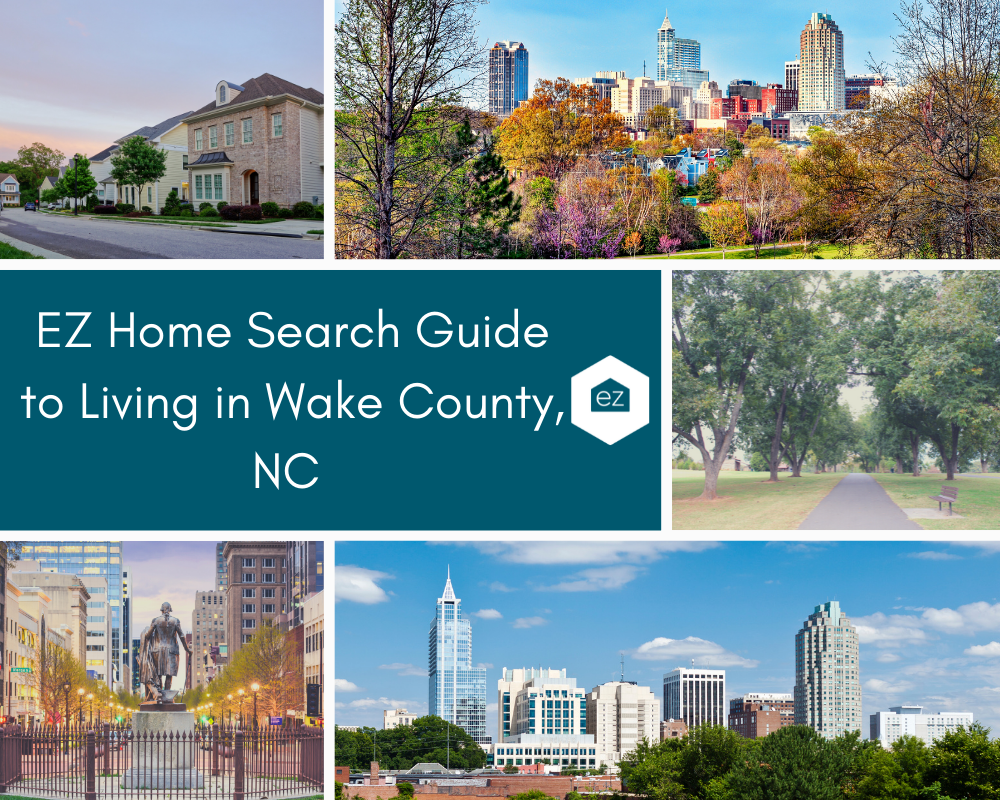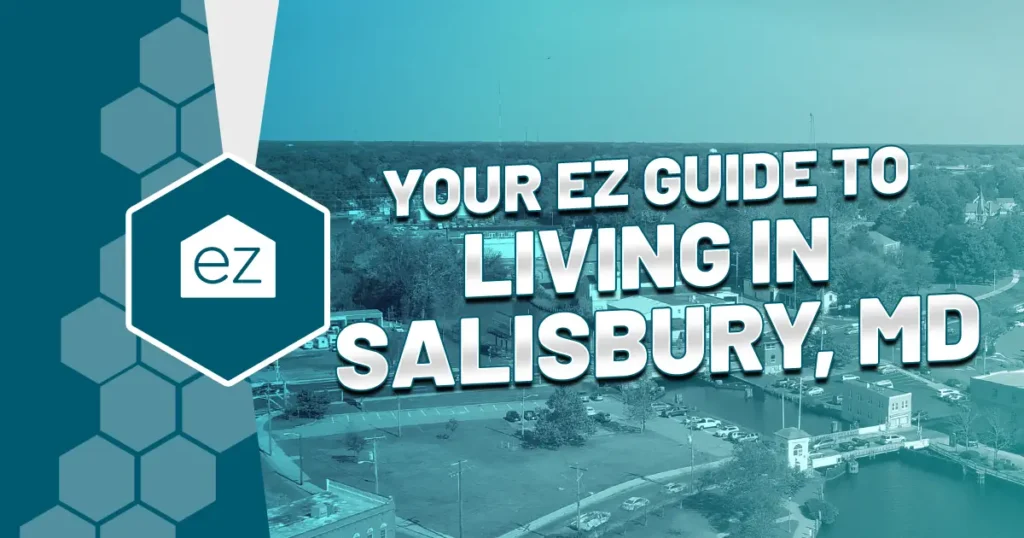EZ Home Search Guide to Living in Wake County, NC
EZ Home Search Guide to Living in Wake County, NC
Wake County, NC, in the heart of the Triangle Region, and part of the state Capitol. Over one million people call the greater area home, and for a reason. Living here puts you near some of the nation’s top health care facilities, innovative companies, and leading educational institutions. With over 26,000 acres of water recreation and 117 miles of recreational trails, residents enjoy a great outdoor lifestyle as well as plenty of lifestyle, dining, and shopping amenities.
Are you moving to the Triangle region soon? Learn more about living in Wake County.
About Wake County
As one of the fastest-growing areas in North Carolina, Wake County is the 17th most populous of North Carolina’s 100 counties. More than one million people live within its 849 square miles, and over 40% of residents live in Raleigh.
Wake County is where the Piedmont and Atlantic Coastal Plain regions meet. Much of the land is gently rolling hills sloping down towards the coastal plains. The central location places residents about three hours from coastal North Carolina and four hours east of the Great Smoky Mountains.
Inside and surrounding Wake County are several water reservoirs, like Falls Lake and Jordan Lake. Lake Crabtree, Lake Johnson, Neuse River, Moccasin Creek, and Crabtree Creek provide opportunities for water recreation.
Surrounding Wake County is Granville, Franklin, Nash, Johnston, Harnett, Chatham, and Durham Counties.
Wake County enjoys a moderate subtropical climate, with moderate temperatures in the spring, fall, and winter. Winter highs generally range in the low 50Fs with lows in the low-to-mid 30s°F, although an occasional 60F or warmer winter day is not uncommon. Spring and fall days usually reach the low-to-mid 70s°F, with lows at night in the lower 50s°F. Summers are typically hot with high humidity.
Wake County History
Wake County was formed in 1770 from parts of Cumberland County, Johnston County, and Orange County. The first courthouse was built at a village originally called Wake Courthouse, now known as Bloomsbury.
During the colonial period, the state capital was New Bern. For several years during and after the Revolutionary War there was no capital, and the General Assembly met in various locations. Fayetteville was the state capital for various years in 1786-1793. Raleigh was made the permanent capital in 1794.
Wake County was named after Margaret Wake Tryon, the wife of Governor William Tryon.
In the 1800s, the first private schools in North Carolina were built in Wake County.
The Battle at Morrisville Station was fought April 13–15, 1865, in Morrisville, North Carolina, during the Carolinas Campaign of the American Civil War. It was the last official battle of the Civil War between the armies of Major General William T. Sherman and General Joseph E. Johnston.
After the Civil War, the rural agricultural economy struggled until monoculture commercial farming became predominant. The first railroad was built, connecting the county to other areas of commerce. The first textile mill was founded in 1909. With the rise of manufacturing, many people flocked to work in urban areas, including Raleigh, Cary, and other towns throughout Wake County.
Modern Wake County is rapidly transforming into a commercial and industrial hub, with many subdivisions and residential development.
Wake County Cities and Areas
Throughout Wake County are twelve municipalities that are suburbs of the city.
Cary is an active community with many residents interested in outdoor activities like bicycling, hiking, jogging, and trail running. Cary, NC offers all the amenities of a major urban area within its limits. AdvisorSmith called Cary the no. 3 safest midsize city in America.
Apex is a small town with many retired residents and families. The town is the home to Beaver Creek Plantation, one of the largest golf communities in North Carolina.
Holly Springs was founded in 1839 as Mechanicsville but was renamed after the Holly Springs Baptist Church in 1854.
Knightdale was established as a railroad town to move agricultural goods. A fire virtually wiped out the entire town in 1940, but it rebounded in the World War II baby boom.
Morrisville began as a railroad village in 1854 but was not incorporated until 1872. Niche.com ranked Morrisville the no. 1 place and suburb to live in North Carolina.
Raleigh is the state capital of North Carolina and home to North Carolina State University. The centerpiece of Raleigh is the beautiful and dynamic downtown area. Raleigh, NC is a diverse community with a mix of residents from all walks of life.
Rolesville was established in 1886 and was named for Robert Roles, who donated the land for the new townsite and sold lots to encourage railroad service.
Wake Forest is a small town with many retired residents. The town offers an excellent location for outdoor recreation, close to both Falls Lake and Kerr Lake.
Wendell is one of the fastest-growing communities in eastern Wake County, with a strong agricultural base. The town was chartered in 1885.
Zebulon is located east of I-95 along US 64 Bypass on what has become known as the “Historic Rolesville Highway.”
Getting around Wake County and Raleigh, NC
Wake County is the central county of North Carolina. Located in the heart of the Triangle Region, with easy access to major roads and highways, residents don’t have to travel far for entertainment or shopping.
I-40 travels southeast to northwest through the center of Wake County from Wilmington, NC to Hillsborough, NC.
I-440 circles the center of Wake County and connects with I-40 at two points in Raleigh. This is an easy way to get around Raleigh.
I-540 begins in northern Wake County and ends in southern Wake County west of Garner, NC. It connects with I-40 and I-87 outside Raleigh.
I-87 runs from outside Eagle Rock, NC, into the I-440 belt.
Wake County Real Estate Market
The Triangle real estate market has grown steadily in recent years. With job growth up and unemployment rates down, home prices are on the rise, too.
Wake County is home to many historic areas, including Raleigh’s Mordecai, Bloomsbury and Oakwood neighborhoods. While Raleigh itself often receives the most attention, other communities in Wake County are worth exploring, too.
Homes for sale in Wake County have a median list price of $434,140 in January 2022, a year-over-year increase of 25%. However, there are still homes to be found priced around $300,000 that you can afford with the right mortgage.
The median days on the market were 13. The months’ supply of inventory stands at 0.3 months or just over one week. The number of new listings was down.
Looking at the median sale price historical trends, Wake County has seen many up and down cycles, with a general upward trend. Median sale prices escalated around July 2021, reaching new all-time highs.
PWC ranked Raleigh-Durham the no. 2 real estate market to watch in 2022.
Wake County Demographics
As of the 2020 US Census, Wake County has a population of 1,129,410. This represents an increase of 20% over the 2010 Census figure. There are also 400,172 households in Wake County, with an average household size of 2.62 persons. The county projects it will add 250,000 new residents over the next decade.
While the median age for Wake County residents is 37 years old, 46% of Wake County’s population growth came from people aged 55 and older. Population statistics indicate that there are nearly as many females as males.
The race and ethnicity breakdown is 60% caucasian, 21% black or African American, 10% Hispanic or Latino, and 7% Asian.
Wake County Economy
In the mid-1910s, a shift from agriculture to other jobs occurred. Today, Wake County is a science, health care, and education hub. Important industries are in the life science industry, specifically pharmaceuticals and biotechnology. Other sectors include communications technology, advanced materials, and railroad equipment.
In 2022, Apple announced a plan to invest $1 billion in North Carolina and to build a new campus at Research Triangle Park. It was one of several major companies investing in local jobs.
The top employers in Wake County, based on size, were Duke University and Duke Health Systems, State of North Carolina, Wake County Public School System, Walmart, the University of North Carolina at Chapel Hill, WakeMed Health & Hospitals, North Carolina State University, Food Lion, Target Stores, and IBM.
Major companies such as IBM, SAS, Red Hat, Siemens, and Lenovo have headquarters in Wake County.
Research Triangle Park is among the largest research parks in the United States. The park has 7,000 acres of office space and employs 41,000 people.
Wake County Education
Wake County Public School System currently runs 194 schools and is growing. There are 117 elementary schools, 37 middle schools, 31 high schools, six alternative schools, and three (k-8, 6-12) schools. The school system has a budget of $1.94 billion and employs 19,500 people across the county.
The WCPSS is home to several top-performing schools in the state and nation. Davis Drive Elementary was ranked no. 5 in the state by US News and World Report in 2022. Mills Park, Highcroft, Green Hope, and White Oak Elementary; Wake Young Women’s Leadership Academy and Mills Park Middle; Wake NCSU STEM Early College, and Panther Creek High School were all in the top 20.
In addition, Wake County is home to several universities, with a total of five colleges and 11 universities in the greater area. Local colleges include NC State University, Saint Augustine’s University, Wake Technical Community College, Shaw University, and Peace College.
Wake Technical Community College is part of North Carolina’s community college system and offers nursing, carpentry, automotive technology, and diesel mechanics. Best Value Schools ranked it the no. 1 community college in the US.
NC State University is ranked no. 1 public school in North Carolina and is one of the top research universities in the country.
Meredith College is a private four-year school and the only women’s college in North Carolina and one of very few nationwide.
Saint Augustine’s University was established as a private four-year HBCU and has become one of the premier African American universities in the nation.
Shaw University is a private liberal arts school known for its business, divinity, and law programs. It was the first HBCU in the South.
William Peace University is a private Methodist four-year university with an average undergraduate enrollment of 520 students.
Wake County Hospitals & Medical Centers
Wake County is home to several hospitals that provide high-quality job opportunities to the community. WakeMed Health & Hospitals, Rex Healthcare, and Duke Raleigh Hospital are all in good standing with their surrounding communities.
WakeMed Health & Hospitals is a not-for-profit health system that operates several large, tertiary, and specialty hospitals serving the community. WakeMed is home to a Level 1 Trauma Center and serves over 1,000 inpatients per day. In 2011, the organization was selected as one of five sites for a joint replacement study by Medtronic Spine. WakeMed employs more than 3,500 people.
Rex Healthcare is an integrated health system that offers acute care services at Rex Hospital and outpatient services at Rex Health Center. The health care system is a member of UNC Rex Healthcare, a collaboration between the University of North Carolina School of Medicine and Rex Healthcare System.
Duke Raleigh Hospital is an acute-care teaching hospital that serves the northern part of Wake County. Duke Raleigh is home to several medical specialties, including emergency services, neurosciences, maternity, and orthopedic care.
Wake County Things to Do
Raleigh has an active arts community. With cultural options ranging from museums to live theater, Raleigh offers something for everyone.
Raleigh is home to the North Carolina Museum of Art (NCMA), one of America’s most visited art museums. The museum opened a new building in 2010 and features an outdoor amphitheater and garden that hosts concerts and events.
North Carolina State University hosts several arts attractions on campus, including performances at Reynolds Industries Theater and Talley Student Center Theatre.
The Duke Energy Center for the Performing Arts is a large multi-venue center that hosts a mix of music concerts, dance, opera, and theater productions.
The North Carolina Symphony performs at Meymandi Concert Hall and Fletcher Opera Theater in Raleigh. In September, the orchestra also holds an annual free concert at Red Hat Amphitheater.
Wake County is home to several festivals and events throughout the year. The North Carolina State Fair is an annual tradition that draws over one million people each year. In April, be sure to head down to the NC State Farmer’s Market for Tomato Fest, and in December, enjoy HolidayFest on Fayetteville Street. The city also hosts several festivals such as Artsplosure and Lazy Daze each May and October, respectively.
Don’t miss First Night Raleigh, a New Year’s Eve celebration that includes a firework show above the State Capitol building and family-friendly events at local venues, including Red Hat Amphitheater.
If you’re searching for outdoor adventure, you won’t have to look far from home. More than 100 miles of paved greenway trails are accessible for hikers, bikers, and horseback riders. Visitors will also love Falls Lake, Harris Lake, Lake Wheeler, and nearby Jordan Lake, which, when combined, account for more than 27,000 acres of water.
Don’t forget the Carolina Hurricanes, the Carolina Mudcats, and the Durham Bulls for sports fans. For ACC fans, attend home games with the NC State Wolfpack, North Carolina Tar Heels, and Duke Blue Devils.
Wake County is home to several golf courses, including Lonnie Poole Golf Course in Raleigh and TPC Wakefield Plantation.
Wake County Dining
Wake County is home to an eclectic mix of dining options. Zagat has rated Raleigh one of America’s hottest food scenes while USA Today called it one of the most underrated on the East Coast. Local chef Ashley Christensen is North Carolina’s only James Beard award winner.
From traditional Italian and Greek fare to international and contemporary American cuisine, the many restaurants in Wake County offer something for everyone. Enjoy farm-to-table dining and global inspirations. Find a variety of chain and local-owned restaurants.
Wake County Shopping
Wake County has more than 100 shopping centers featuring local designers, national brands, high-end boutiques, and unique gifts. Triangle Town Center, Crabtree Valley Mall, and Cary Towne Center are the largest shopping centers in Wake County.
In addition to these, several newer shopping centers include Brier Creek Commons, White Oak Crossing, and Crossroads Plaza. For those that want to live near work and shopping, be sure to check out the pedestrian-friendly, mixed-use developments at Cameron Village and North Hills. Of course, you can always hit up the local stores in downtown Raleigh or the Village District.
Living in Wake County
Wake County, NC, is one of the fastest-growing areas in the nation, thanks to its easy access to Research Triangle Park. Beyond the high-tech job opportunities, education, and health care, Wake County offers a lifestyle steeped in arts, culture, entertainment, and recreation.
Start Your Home Search
Preston Guyton
Share this Post
Related Articles
Living In
Your EZ Guide to Living In Salisbury, MD
Living In






